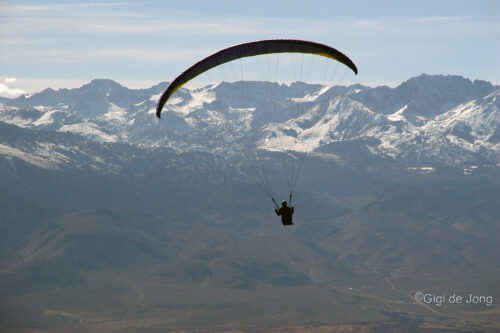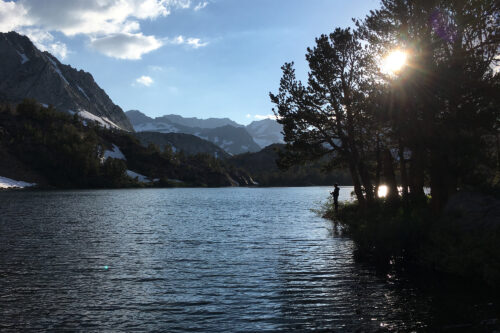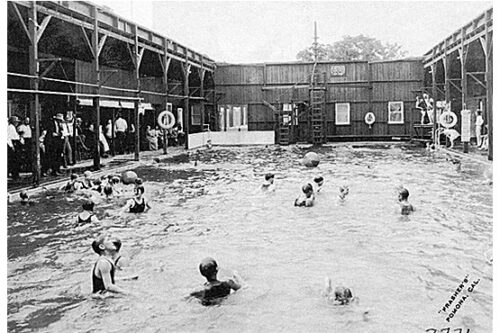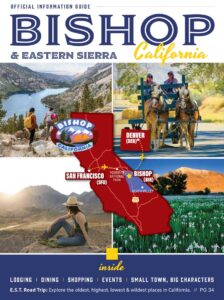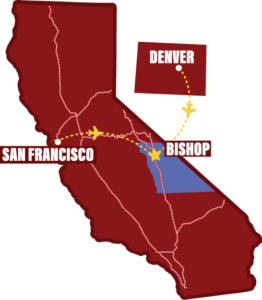The Artist Bishop Nabbed from NASA: A Conversation with Steven White Woodworking
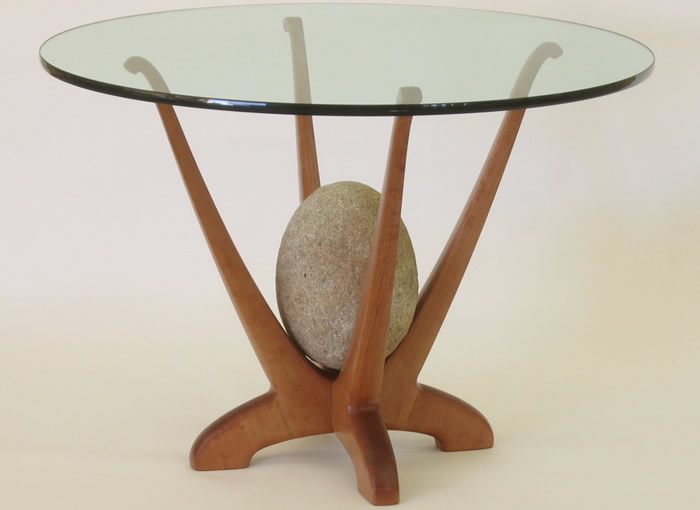
Every night—if I want to get any sleep—I have to climb a ladder.
I am not Rapunzel. I just sleep in the loft of my cottage. Descending while half-awake in the morning might seem treacherous, but the ladder I climb is a sturdy work of art. It’s the color of cherries and honey, the rungs curved and sanded smooth.
One rainy November morning, I visited the place my ladder was made: a workshop in downtown Bishop, presided over by the artist Steve White.
The ceilings in the shop soar, and the air smells of sawdust. Steve greeted me in work overalls. He paused in sanding the legs of a dining room table, a special order for a customer in Reno.
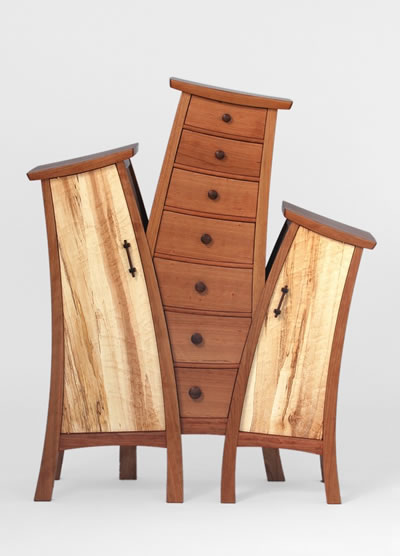 For twenty years, Steve White has been creating furniture and smaller works of art here in Bishop. IKEA can take a hike. You won’t find pieces like Steve’s curved dressers, stools, rocking chairs, and mirrors anywhere else, in part because of the way the Eastern Sierra landscape plays into his work. A coat hanger carved in the shape of the Sierra crest hangs in my dad’s house, and a gleaming coffee table sits in mine, its corners peppered with little round holes. The design gives the table personality, and I love the story—the round “bubbles” are inspired by ice skating in the high country. “These are the air bubbles you find in frozen lakes,” Steve said, “all different sizes, nested together.”
For twenty years, Steve White has been creating furniture and smaller works of art here in Bishop. IKEA can take a hike. You won’t find pieces like Steve’s curved dressers, stools, rocking chairs, and mirrors anywhere else, in part because of the way the Eastern Sierra landscape plays into his work. A coat hanger carved in the shape of the Sierra crest hangs in my dad’s house, and a gleaming coffee table sits in mine, its corners peppered with little round holes. The design gives the table personality, and I love the story—the round “bubbles” are inspired by ice skating in the high country. “These are the air bubbles you find in frozen lakes,” Steve said, “all different sizes, nested together.”
As a kid, Steve was always building boats and tree houses. He went to engineering school and worked for NASA for three years, but the job was mostly design and not enough building, so Steve went into business for himself. As a carpenter and woodworker, he did additions and remodels, which lead him to design wooden staircases. “I got into curved stairs and spiral staircases,” he said, “and I just ran with that for about ten years, because it combined my knowledge of math—trigonometry—with my ideas for curved shapes.”
In Steve’s shop, I got to learn about mortise and tenons, the sneaky components you never see that keep your dining room table from tipping over. “There are definitely structural considerations when you make furniture,” Steve explained. “You need this piece to be thick enough that it doesn’t bend, but not so thick that it looks clunky. A table needs a sturdy base so the top doesn’t tip.”
I learned about different types of wood. Pine, it turns out, is not that exciting. Elm is hard on tools. “I’m spending so much time on the labor of a piece that I want really beautiful figured wood, with lots of grain to it,” Steve said. His favorite woods are cherry, maple, and walnut.” The tall, fragrant planks that lean against the shop walls might end up as a table top, the drawers of a dresser.
Steve showed me zebra wood from Africa, which looks just the way it sounds, and planks of spalted maple, a pale wood etched with fine black lines, carved into the tree by fungus. “Sometimes they leave the wood on the ground on purpose and let the fungus get in it,” Steve said. “Some places think it’s garbage, and they give it away as junk.”
Rewind two decades, and Steve is making wooden staircases in the Bay. “It was going along really well—and then we moved to Bishop.” Oofta. Moving to Bishop can be, as many of us know, a blow to a career. Yet even as a kid in Pennsylvania, Steve hung posters of Rocky Mountain peaks on his bedroom walls. He knew he wanted to live near mountains.
What landed Steve and his wife Sarah in Bishop, instead of some place like Tahoe or Mammoth? Sarah wanted to have a garden. (Thank you, Sierra snowmelt.)
“At first I thought, geez, that’s a really hot place,” Steve said. “But okay, let’s do it!”
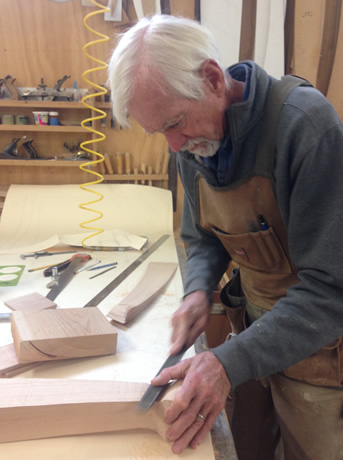 That was twenty years ago. “I’m really glad,” he says now. “We couldn’t have made a better choice. The mountains here are great and I expected that, but I didn’t expect the sense of community. There’s a really great community here in Bishop. It’s a real place.”
That was twenty years ago. “I’m really glad,” he says now. “We couldn’t have made a better choice. The mountains here are great and I expected that, but I didn’t expect the sense of community. There’s a really great community here in Bishop. It’s a real place.”
This real place isn’t the easiest for woodworking, however. Steve can’t get lumber in the Eastern Sierra—he has to haul it from San Francisco on the rack of his pickup. Shipping is tricky, too, since his furniture needs to be wrapped in blankets. But Steve says it’s worth it. “I didn’t do my career any favors by moving over here, to the middle of nowhere,” he said. “But for me it was more important to have the lifestyle, and then figure out the work.”
Perhaps the very challenges posed by the Eastern Sierra contribute to the sense of community that keeps Steve hauling all that lumber. Here, we all have something in common: our relationship to the landscape, no matter how we might articulate that differently. The isolation and extremity of our environment serves as an automatic icebreaker.
“That’s why so many people care about this place,” Steve said. “Because it’s rare.”
Impressively, about half of Steve’s customers are local, and most of them are repeat. “Bishop is not a wealthy community in general, so I’m appreciative of all the customers I’ve had,” he said.
The three-dimensionality of the Eastern Sierra landscape feeds Steve’s aesthetic sensibility, and the landscape works into his pieces in surprising ways, from cattail wall hangings to glass-topped tables counterweighted by eighty-pound granite boulders.
For customers looking for something smaller, Steve builds ski hangers, clocks, Sierra crest coat hangers, and tabletop art made from sedimentary rock and pinecones. “I like curves. And nature is pretty much curves,” Steve said.
I wondered what Steve’s art might look like, had he been working for twenty years someplace else. We decided this was unimaginable.
“A lot of my inspiration comes from within myself, but I’m drawn to mountains,” he said. “That’s where I wanted to be, all my life. I don’t think I could have ended up anywhere else.”
Here in the Eastern Sierra, we’re so lucky to be home to artists of Steve White’s caliber. (Sorry, NASA.) You can check out his work at www.stevenwhitewoodworking.com.
Written by:
Kendra Atleework
Kendra Atleework is the author of Miracle Country, a book about the Eastern Sierra, which won the Sigurd F. Olson Nature Writing Award, the Women Writing the West WILLA Literary Award in Creative Nonfiction, and was chosen for the statewide program Nevada Reads. She lives in Bishop.
